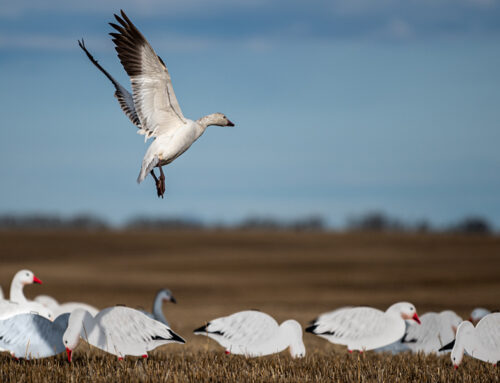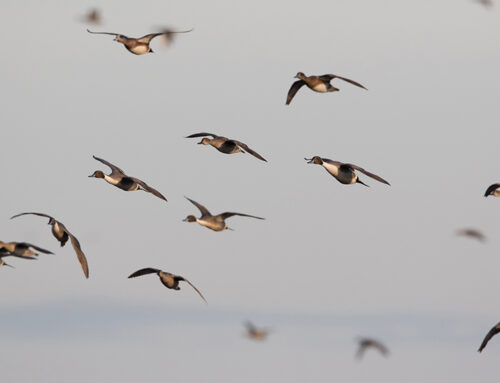Resourcefulness Can
Save the Hunt
Save the Hunt

By Joe Shead
I’d been watching a flock of ducks through my binoculars for the better part of an hour. They were about 300 yards away, but unless I missed my guess, eventually they would get up and fly over my decoys just as midmorning birds tend to do at the spot.
There were a dozen or so mallards, but what really had my attention was the lone black duck mixed in with the flock. If I got my chance, that’s the one I really wanted.
Sure enough, after about an hour of milling around, the black duck got up with the rest of the mallards in tow — here they came, right at me. When the dusky leader was out over my decoys, I rose, shouldered my gun and squeezed the trigger. The normal “boom” of my 12-guage, however, sounded much more like a “pop,” and I watched as several BBs rolled out the end of my barrel. It was the first dud shell I’ve ever had in more than a quarter-century of waterfowl hunting. I pumped the gun, bent on getting a crack at that black duck. But an instant before I pulled the trigger, an alarm went off in my brain and I held fire, watching my trophy slip harmlessly away.
I unloaded the shotgun, unscrewed the barrel and peered into it. Sure enough, the wad from the dud shell never made it out the end of the barrel. I lost a chance at a black duck, but I shudder to think what could have happened if I had fired with a wad plugging my barrel.
I didn’t have a ramrod along, and I didn’t want to end my hunt early. That’s when my gaze fell on a stand of cattails. The stalks were narrow enough, yet sufficiently stout to serve as a perfect ramrod. I easily removed the wad and resumed my hunt.
Over the course of a waterfowl season, hunters must adjust their tactics, hunting areas and even camo patterns to match changing conditions. Hunting geese in green alfalfa fields in September calls for a different approach than hunting on a frozen river in December. Hunters think nothing of making these gradual, seasonal shifts, but sometimes we have to make quick adaptations on the fly. Like a camo-clad MacGyver, using what’s available to you in the field can save the day.
Floating Goose Shells
Consider a late-season goose hunt I experienced last year. A backwater slough of the river had frozen, and I knew geese were roosting on the ice — both by kicking them out of the area one morning and the telltale goose droppings on the ice.
I returned a few days later with a load of shell decoys to place on the ice. However, surprise: All the ice had melted! I now had a bunch of shell decoys, but nowhere to place them.
Hunting without decoys didn’t seem like a good option, so I had to figure out a way to set a spread. The river often has a lot of debris that gets washed downstream, and I figured I could find some lumber. I was thrilled when I came upon a thick, long plank floating in the water. It was the perfect platform on which to put some shells. At other times, I’ve placed goose shells over duck floaters to keep them aloft.
Or you may find yourself in the reverse situation: If you need to set out a large field spread, but you only have a couple dozen shells or full bodies, you can always use your floaters to add more numbers. If they don’t have removable keels, prop them with a stick on either side.
Plan for the Unexpected
You never know what challenges you might face in the field on any given day. That’s why it’s always a good idea to have a few simple items along that can help get you out of a jam. Make a practice of keeping some rope, duct tape and MacGyver’s favorite — a pocket knife — in your blind bag. A small tool kit consisting of a couple screwdrivers, pliers, some wrenches and a socket set can prove useful.
Even if you try to prepare for any situation, you’ll need to be resourceful when the unexpected arises. Need to tie something? Don’t forget you have string on your floating decoys. Gotta take a measurement? A dollar bill is exactly 6 inches long. And those 3-inch shells are, well, 3 inches! Branches, cattails, rocks and other natural items can be useful tools in a pinch.
Block Ice Floes
Another river hunt several years ago presented a different challenge. Chunks of ice were steadily flowing down the river. These 2- to 4-foot chunks would hit our mallard floaters and carry them downstream. We were constantly trying to save or readjust our spread. That’s when one of the members of our group came up with a brilliant idea: He pushed some sturdy stakes into the water and tied a log to them at water level. With the outer stake positioned downstream of the inner, it diverted the icebergs around our spread perfectly.
Get Out of a Jam
Sometimes, being resourceful goes beyond prolonging your hunt — it could get you out of some serious trouble. A shell box can be used as a boat bailer. Floating decoys in a cinched bag can serve as an emergency flotation device. And sticks or logs shoved into your wheel ruts can help you get traction if you get your truck stuck.
It’s smart to be prepared and carry basic supplies before venturing afield, but don’t be afraid to get creative and draw on your resourcefulness. It could resolve a bad situation, help you shoot more birds or even save your life.




Leave A Comment